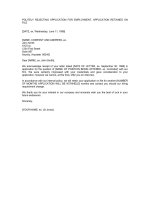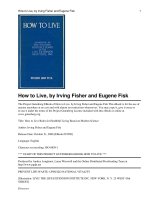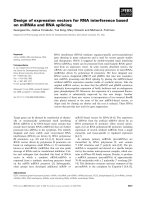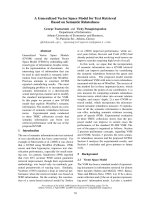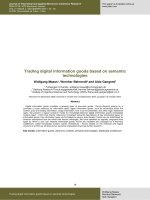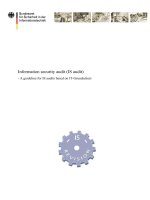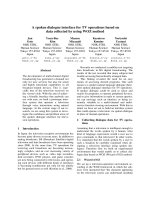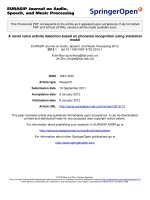Path planning for autonomous vehicle based on heuristic searching using online images
Bạn đang xem bản rút gọn của tài liệu. Xem và tải ngay bản đầy đủ của tài liệu tại đây (13.43 MB, 12 trang )
Vietnam J Comput Sci (2015) 2:109–120
DOI 10.1007/s40595-014-0035-4
REGULAR PAPER
Path planning for autonomous vehicle based on heuristic
searching using online images
Van-Dung Hoang · Kang-Hyun Jo
Received: 16 June 2014 / Accepted: 19 November 2014 / Published online: 4 December 2014
© The Author(s) 2014. This article is published with open access at Springerlink.com
Abstract In automatic navigation of mobile systems, a
path network is required to enable robot/vehicle autonomous
motions. Path planning is considered as a significantly important part in creating the path network and thus to be a necessary task for any autonomous vehicle system. This paper
proposes a method that constructs the shortest path for vehicle auto-navigation in outdoor environments. The method
using two layers of GIS information of online map images,
which support to estimate not only the shape of road network but also the directed road. This is also the advantage as
compared to methods, which use only aerial/satellite images.
Accomplishing the estimation according to the use of this
application requires several stages as follows. First, a raw
road network is detected using the road map and the satellite
image. Second, the road network is refined and represented
by a direct graph. Third, the road network is converted into the
global coordinate, which is much more convenient for performing online auto-navigation task than the other types of
coordinate. Finally, the shortest path for motion is estimated
by heuristic searching method based on a hybrid algorithm
that is originated from Dijkstra algorithm in a combination
with greedy breadth-first search algorithm. The experimental
results demonstrate robustness and effectiveness of the proposed method for path network estimation under large scenes
of outdoor environments.
V.-D. Hoang (B) · K.-H. Jo
School of Electrical Engineering, University of Ulsan,
Ulsan, Korea
e-mail: ;
K.-H. Jo
e-mail:
Keywords Road network detection · Autonomous
navigation · Path planning · The shortest path estimation ·
UTM/WG84 coordinate system
1 Introduction
Nowadays, there have been many research areas on intelligent systems, autonomous robot in outdoor environments,
especially intelligent transportation in outdoor environments,
such as in [1–3]. Autonomous vehicle navigation becomes
an important in various applications of motion path planning, localization task. In automatic navigation of mobile systems, path planning is required to create path network for any
robot/vehicle auto-traveling and considered to be the initial
step in any autonomous vehicle systems. So far, researches
on path planning have been achieved several milestone successes in industrial applications as well as in academic disciplines, including applications in mobile robot/vehicle and
aerospace. There are many studies on the planning algorithms and implementations [4]. So far, there have been several proposed methods for road detecting and path planning
[5–7]. Studies on planning algorithm and implementations
have considered the issues of road detection and path planning. They can be categorized into two folds of global and
local path planning methods, respectively. The global path
planning is concerned with the high-level path, the whole
path for movement from the source to the destination of
travel itinerary. It deals with the navigation around the global
region. Contrarily, the local path planning is related to the
low-level path, which is suitable for further detail of specific
paths. In essence, it is a segment of a certain global path but
with more details to allow for avoiding local obstacle. An
autonomous robot/vehicle has to deal with in reality such as
determining appropriate turning-angle and speed.
123
110
The objective of this paper is to develop an efficient application for constructing the shortest path, which provides a
real trajectory for autonomous vehicle navigation in the outdoor environments. Although path planning product can be
provided by several commercial services, these services are
typically with high cost and sometimes not all of its characteristic will be used or valid for the actual demand of a user, e.g.,
traffic conditions might not be useful for some applications or
some special regional is not updated in the commercial version. In our proposal, the global path for vehicle motion is
self-constructed using road map and satellite images, which
are retrieved from free charge online service. In the case that
roads are outdated in some regions of the map services, updating map is required and can be performed by road detection
using aerial/satellite images. The proposed method consists
of several parts as follows. A road network is estimated using
road map and satellite images, which is retrieved from online
map services, such as Google Maps, OpenStreetMap, and
Bing Maps service. The road network is refined using some
image processing techniques. The road network in image
pixel coordinate is converted into the global coordinate system, so that it provides more convenient for online vehicle
navigation. Finally, the shortest path for vehicle motion is
estimated based on the shortest path planning algorithms,
such as Dijkstra, greedy breadth-first search algorithm.
2 Related work and proposed method
In recent years, some of the most convincing experimental results have been obtained using promising methods for
motion planning. The global path planning method based on
the modification of rapidly exploring random tree algorithm
is presented in [8]. The method was constructed for providing
effective partial motion and achieving the global objective.
Another group of researchers in [9] presented a motion planning method based on guided cluster sampling. That paper
developed a point-based partially-observable Markov decision process (POMDP) approach along with a consideration
of the motion error, the sensing error, and an imperfect environment map for robot’s active sensing capabilities. Experimental results show that the approach contributed an efficient
method for balancing sensing and acting to accomplish given
tasks in various uncertain conditions. However, the method
requires high computational cost to find an optimal solution [10]. To adapt to variety and uncertain conditions, Toit
et al. [11] presented a method for motion planning based
on integral individual components of dynamic and uncertain
environments in planning, prediction and estimation. In outdoor scenes of transposition, the traffic laws are used to estimate behaviors of the dynamic interactive systems, predict
their future trajectory, and constrain the future location of the
moving objects in uncertain environments. In the case of the
123
Vietnam J Comput Sci (2015) 2:109–120
global path planning for motion under certain maps, the computational time of that method becomes expensive when it is
applied to high-level of the motion planning. Another group
of authors in [12] focused on an interpolation method for
optimal cost-path-motion function based on the well-known
algorithms Dijkstra and A*. These authors exploited advantages of each method to provide an effective method for estimating feedback of a plan. It estimates the shortest path for
motion on simplicial complex of an arbitrary dimension. The
computational cost is significantly reduced by implementing
an A*-like heuristic.
In the field of path planning for motion in outdoor environments, there have been some groups of researchers focusing
on road detection and plan a path-trajectory for robot/vehicle
motion by using aerial images [5,6,13–15]. Typically, the
authors in [5] used a neural network to detect roads on highresolution aerial images. In that paper, authors analyzed to
learn roads based on the road surface context so that it could
reduce misdetection, e.g., the roof of buildings is likelihood
with the road surface without the context of surrounding
scenes. Chai et al. [6] presented a method to estimate a road
network based on the Monte Carlo mechanism using sampling junction-points input images. That method focused on
investigating the shape and extracting the structure of a road
from its nature texture. However, those methods could not
overcome the case when roads are fully obscured by high
buildings, tunnels and trees.
On the contrary, instead of focusing only on path detection
using the aerial/satellite images, our proposed method uses
the high-level of road map and terrain images to detect a path
network. The road maps are provided from online services
without any charges. Our proposed method takes advantages
of the prior knowledge maps, which provide by maps developers, to simplify the road detection task with high accuracy
and low computational cost. By this approach, the path network is estimated in not only term of shape roads but also the
directed network. For simplicity, it is assumed that the prior
knowledge of map services is believable and their incorrect
information can be regardless. On the other circumstances,
such as that road map does not contain updating information,
it is detected based on aerial/satellite image. The contribution
focuses on planning the global path for autonomous navigation, which is self-constructed by using two layer of GIS
information: road layer and terrain layer. The general method
for constructing a road network to plan path for vehicle navigation is presented in following flowchart, as depicted in
Fig. 1.
3 Road network detection
In this method, for filtering out road regions, the statistic
of color channels is used. The representative colors of road
Vietnam J Comput Sci (2015) 2:109–120
111
regions on map images are separated into several classes with
regard to the number of the road hierarchy of map services.
The representative colors have specific color characteristics.
To investigate the color features, we built our own road database for training, which then results in giving the following probability density functions (PDF) of the red, green,
and blue channels, as depicted in Fig. 2. The road candidate
regions are estimated using Gaussian probabilities based on
color channels. Probability of pixel x belonging road candidate r is defined as following formulation:
P(r |xc )
P(r |x) =
(1)
c∈C
Fig. 1 The general flowchart of proposed method
where x is pixel image, C is color channels (red, green, blue).
Different from the previous methods [5,6], the images are
retrieved from the map service with low-resolution image in
this paper. The road candidates are disconnected as result of
noise and other annotations of the map, as depicted in Fig.
5a, b. Notice that some places of the world maps with respect
to commercial services cannot remove annotations due to the
map service. To deal with this problem, a rolling ball method
is proposed for connection the discontinuous roads.
Fig. 2 Probability distribution color channel of road regions
123
112
Fig. 3 The rolling ball method for refining road detection result
The rolling ball method is briefly described as follows. A
region is considered as a candidate that can be selected as a
road region, also known as a road candidate region (RCR), if
it consists of a dense circle with the minimal radius rmin . The
circle belongs to the RCR is called as a ball if the circle is
defined by the maximal radius. The ball of a specific RCR is
denoted by B(c, r ), where c and r are the center and the radius
of the circle, respectively. The ball can roll in any direction
on road regions. When the ball meets the end of the RCR, it
continues rolling into the non-RCR with a further distance
dths , in the same direction. If it reaches another RCR, this
non-RCR is now considered as a RCR, as shown in Fig. 3.
Direction of a road is estimation on the basis of a narrow
signal as shown in annotations of the map in Fig. 4. Finally,
the path network is presented by a directed graph. Each node
is represented by either the intersection point or the ending of
a road, as illustrated in Fig. 5d. In the graph, an arc is a path
segment, which connects two adjacent nodes (intersection
point or ending point).
Let us consider case of some road segments, which are
not annotated by map services, as depicted in Fig. 6a. The
detection results of road using satellite image are the complement of road map that was already extracted from road network, as illustrated in Fig. 6c. The road regions are estimated
based on color-based filter combining with edge-based filter
that is responsible for estimating boundaries of segment road
regions. In this step, the result of road region in previous step
is used to construct a training dataset from the corresponding regions of the satellite images. This task is learning local
spectrum of road regions.
There are some characteristics of road, which can be investigated to detect appropriately road region. Road surfaces
can be paved or unpaved. Therefore, spectral characteristic
of roads are not uniform, particularly in the case of unpaved
road. This characteristic thus requires the learning of the color
model in local areas for detecting in surroundings areas of
the detected road regions based on road map result in previous step. The width of road is almost constant. The ratio
of length/width of road is usually larger than that of building roofs. It is different to building roof, which is isolated
with other parts. First, all detected road pixels on road layer
image are mapped into satellite image to construct a train-
123
Vietnam J Comput Sci (2015) 2:109–120
ing dataset for learning spectrum color model, as depicted in
Fig. 7b. This color model is also used to filter out candidate
of road region in the satellite image. The result of candidate
road regions is shown in Fig. 7c.
The 2D edge detector based on Gaussian function is used
to enhance the boundaries of roads. The intensity and direction of gradients are obtained by applied filter operator on
intensity image. The filter results are obtained by convolving
the gray satellite image with kernels of Gaussian with preset standard deviations to vertical and horizontal derivatives.
Non-maximum suppression determines if the pixel is a better
candidate for boundaries. Final boundaries are determined by
suppressing all candidates that connect to strong candidate
of boundaries. The results are demonstrated in Fig. 8.
The road regions are filtered based on dominant boundaries, acceptable ratio of road width/length, combing with
color filter results. The results are integrated with the result
of the color segmentation to discard the false detections, e.g.,
rivers, roof of buildings. To refine road network result, the
geometry of road structure in [6] is used to post-process for
improving the accuracy of road detection. The final result of
network detection is show in Fig. 6c.
4 The global path network
This section presents a module that converts the path network from the image pixel coordinate to the Global coordinate, which is represented by the Mercator coordinate system. Generally, global image services, e.g. Google Maps,
Bing Maps, use similar organization of the world maps [16].
The world map can be represented by two-dimensional map,
which likes a rectangle of 360◦ wide and 180◦ high. The
world map is represented by a pyramid of tiles. The origin of a tile is located at the northwest corner. The top level
(zoom level = 0) has 256 × 256 points, next level 512 × 512
points. For each next level of tile pyramid, the point space
is expanded by doubling of size in both directions x and y.
Therefore, the image pixel at zoom level ξ is converted into
the Mercator coordinate system by following equation:
τ
h
× ξ
2
2
τ
w
X = X0 + x −
× ξ
2
2
Y = Y0 − y −
(2)
(3)
where (w, h) is the size of image, (x, y) is a location of the
point in image, (X 0 , Y0 ) is the located center of image in
the Mercator coordinate. The initial resolution of tile size τ
is 156,543.034 m (the circumference of the Earth in meters
40,075,016.679 m divide 256 points). The part of equation
(y − h/2) × (τ /2ξ ) is used to convert image pixel to meter
unit in the global coordinate (Fig. 9).
Vietnam J Comput Sci (2015) 2:109–120
113
Fig. 4 The arrow signals in the road map image are used for detecting the direction of road
Fig. 5 Path-network detection a road maps image, b road candidates are estimated by color filter and segmentation, c post process to connect the
discontinuous road regions, d path network extraction
123
114
Vietnam J Comput Sci (2015) 2:109–120
Fig. 6 Some road segments are not marked by services a road map image, b satellite image, c road network detection using both of GIS layers
Fig. 7 Color filter a road region result from road map layer, b corresponding road regions in terrain layer (annotated by light-pink) to learn color
model for detection, c road candidate regions (annotated by light-pink) using color detection
Fig. 8 Candidate of road boundaries segmentation results a vertical filter, b horizontal filter, c candidate of road boundaries
A point at the location (X, Y ) in the Mercator coordinate
is converted into the GWS84 coordinate system by following
equations [17], with φ and λ are latitude and longitude in the
GWS84 coordinate.
123
360 X
2π σ
180
π
φ=
2 tan−1 eY/σ −
π
2
λ=
(4)
(5)
Vietnam J Comput Sci (2015) 2:109–120
115
Fig. 9 The Global map coordinate a the Earth map in pixel coordinate, b the Global tile at zoom level 1
On the other hand, a point at the location (φ, λ) in the GWS84
coordinate is converted into the Mercator coordinate in the
meter unit of measurement by following equations.
X =
2π
×σ ×λ
360
(6)
π
(7)
360
where (X , Y ) is a point location in the Mercator coordinate,
σ is the radius of the Earth.
Y = σ log tan (φ + 90)
5 The shortest path estimation
This section presents a method to estimate a path for vehicle motion with the minimal cost of feasible trajectory based
on the road network configuration. There are many methods for estimating the optimal path for motion [4], e.g.
Dijkstra, best-first graph search algorithm, rapidly-exploring
randomized tree (RRT). The shortest path problem in this
paper is considered in two-dimensional Euclidean spaces.
We construct a discrete directed graph as G(V ,E). The set
of vertex V = {vi |i = i, . . . , n} is defined as the set of
intersection and ending points of a road. The set of edges
E = {ei |i = 1, . . . , m} is defined as the set of road segments between a pair of adjacent intersections or ending
points. A road segment, which connects an intersection to
another adjacent one or ending, is represented by two edges
in the opposite direction. In the case of the one-way road,
it is represented by one directed edge. The Euclidean distance is used to compute the cost of each edge based on
distance of sequent points in each road segment. Given a
source position s and destination position d, the path planning problem is to estimate a feasible trajectory T with
the lowest cost for vehicles to travel. The cost-function of
trajectory is a non-negative cost, which is defined by c:
V → R≥0 .
The objective of this task is to find out the shortest path
from the source to the destination under an assumption
that there is no obstacle (the problem of obstacle avoidant
will be deal with in partial motion planning). Combining Dijkstra with heuristic based on the greedy best first
search (BFS) is used to estimate the shortest path on the
huge area of the map because this combination allows
for the flexible and potential searches within a huge area
on the map. This use of the heuristic searching technique
in large graphs is significantly effective, in particular for
restricting numerous computations that are just for examining relevant areas of the input graph in the point-topoint search [13]. The heuristic-based searching method is
therefore to accelerate the search speed when searching
for the shortest path for motion in a wide area of outdoor
environments.
123
116
The major functions of the algorithm are:
Heuristic(u, v): The heuristic function estimates the
distance between two nodes u and v. This cost is added to
make a priority in the forward direction to the destination
location. In the simple case, the Euclidean distance is used
to compute this cost for travel.
Push(V, v): Putting a node v into the set of nodes V .
Pop_Lowest(V ): Withdrawn a node v with minimal
cost to source node in the set of V .
Neighbor_Free(v, V,TRA): Given a set of nodes in
the set V , which are directly connected with v and it was not
traveled (v ∈
/ TRA).
Path(Parent(υ),d ): Given a set of consecutive nodes
of the shortest path in the set Parent from the current note υ
to the source node s.
123
Vietnam J Comput Sci (2015) 2:109–120
6 Experiment
The evaluation results of our method for automatically
extracting the shortest path for vehicle motion in outdoor
environment are presented in this section. The learning
dataset is manually collected from the road regions. In general, there are four kinds of the color patterns of road makers
in road map images. The results of color channel distribution
are presented in Fig. 2. In this paper, we combine both method
for road network detection using both kind of images, road
map and satellite image. This implementation is proposed
for autonomous vehicle working outdoor environment while
other methods using satellite image are very limited to several
special conditions. Road network detection using only satellite images cannot deal with the case of roads fully obscured
Vietnam J Comput Sci (2015) 2:109–120
117
Fig. 10 Typical road is obscured in satellite image (a), but it is annotated in road map image (b)
Table 1 Compare of the
methods use road image and
aerial image
Road image
Aerial image
Require high-resolution images
No
Yes
Overcome occlusion
Confident
Not confident
Depend on update of aerial images
No
Yes
Depend on prior knowledge of road annotation
Yes
No
Computational time (s)
<10
>100
Accuracy (%)
>98.5
<67.3
by high building, trees, and tunnels, as depicted in Fig. 10. In
contrast, road network detection using only road map layer
image is dependent of prior knowledge of the road annotations. Some road segments are not annotated in the road map
services, as illustrated in Fig. 6. The advantage of the road
map layer image-based method is that high-resolution images
are not required and simple algorithm of road detection can be
applied, therefore providing a significant reduction in computational time for road detection. It is suitable to implement the real application for autonomous vehicle in long
travel. The summary of qualitative evaluation is presented in
Table 1.
The image dataset for experiment was automatically
retrieved from Google Maps service. The input parameter of
the center location of regions is manually located. The experiments were evaluated under 640 × 640 resolution image
and at the zoom level 15, 16, 17, and 18. The images at
the zoom level 15, 16, 17, and 18 cover area of 1,222.99
× 1,222.99, 611.49 × 611.49, 305.75 × 305.75, 152.88 ×
152.88 m2 , respectively. Figure 11 shows typical road detection results using both kinds of images, which were retrieved
from Google Maps service and the road networks are superimposed on road map images for easily comparing. The intersection and the ending points of roads are ordinally numbered. In this implement, the intersection of roads at a rotary
position is separated into a set of intersection points, which
depends on the number of road branches and they connect
to other by small road segments, as demonstrated in Fig.
12.
The evaluation results are showed in Table 2. The
sensitivity and precision criteria are used for evaluation
the method. The sensitivity [True positive rate (TPR)] is
computed by #TPR = #True positive/(# True positive +
# False negative). The precision is computed by # Precision =
#true positive /(# true positive + # false positive). The true
positive rate and precision are affected by the zoom level,
that mean under the condition of the same size of images,
the result at higher zoom level is better that of lower.
The road detection is perfect at the 17th zoom level and
higher.
The shortest path result is presented in Fig. 13. In this
experiment, the algorithm (1) is applied to estimate the shortest path for vehicle motion using the image at the 17th
zoom level. The path-trajectory in blue color represents for
the shortest path from the source S to the destination D
with the cost for motion is about 684 m. Google service
results no details of the path for travel in local areas or the
case of unpopular regions, as illustrated in Fig. 13a. This
problem is solved by our proposed method, as presented in
Fig. 13b.
123
118
Fig. 11 Some typical road detection results using road map and satellite images
123
Vietnam J Comput Sci (2015) 2:109–120
Vietnam J Comput Sci (2015) 2:109–120
119
Fig. 11 continued
Table 2 Evaluation road detection
Region
Zoom
level
Segment
path
TPR
(%)
Downtown
University
campus
Fig. 12 Intersect-point at rotary is separated into a set of intersection
points
7 Conclusion
This paper presents the method to construct an efficient shortest path planning based on the road map and satellite images
for autonomous vehicle motion in outdoor environments. The
results consist of path details in global coordinate, which
support for control tracking for autonomous navigation. The
method focuses on the estimation of the path in the global
coordinates without using expensive commercial services.
Intersections/
Ending
Precision
(%)
Time
(ms)
TPR
(%)
Precision
(%)
15
98.9
98.9
99.7
98.4
16
99.3
98.1
98.6
97.8
505
425
17
100
99.2
100
98.8
381
18
100
100
100
100
365
15
99.4
99.1
99.4
98.8
509
16
100
100
100
100
392
17
100
100
100
100
347
It consists of several stages. The road network is estimated
using road map images, which is retrieved from free of charge
online Google Maps services. The road network is refined
and combined with the result of road detection using satellite
image.For convenience in real-time online vehicle navigator,
the road network in image pixel coordinate is converted into
the global coordinate system. The hybrid method based on
the Dijkstra algorithm in combination of greedy breadth-first
search technique is applied to estimate the shortest path. By
123
120
Vietnam J Comput Sci (2015) 2:109–120
Fig. 13 The shortest path estimation a Google result, b our proposed method estimated result from the source S to the destination D, of road
network (denoted by light-blue) and the shortest path (denoted by thick blue)
the use of road map type, which takes advantage of knowledge maps to provide high confident of the shortest path for
vehicle navigation. One disadvantage of this method is that
the method depends on the updating road information. This
problem is compensated using satellite image. The experimental results demonstrate the effectiveness of this method
from large scene of outdoor environments.
Acknowledgments This work was supported by the National Research
Foundation of Korea (NRF) Grant funded by the Korean Government
(MOE) (NRF2013R1A1A2009984).
Open Access This article is distributed under the terms of the Creative
Commons Attribution License which permits any use, distribution, and
reproduction in any medium, provided the original author(s) and the
source are credited.
References
1. Zhang, H., Geiger, A., Urtasun, R.: Understanding high-level
semantics by modeling traffic patterns. In: Proceedings of International Conference on Computer Vision (ICCV) (2013)
2. Murillo, A.C., Singh, G., Kosecka, J., Guerrero, J.J.: Localization
in urban environments using a panoramic gist descriptor. IEEE
Trans. Robot. 29, 146–160 (2013)
3. Hoang, V.-D., Hernández, D.C., Le, M.-H., Jo, K.-H.: 3D motion
estimation based on pitch and azimuth from respective camera and
laser rangefinder sensing. In: Proceedings of IEEE/RSJ International Conference on Intelligent Robots and Systems (IROS), pp.
735–740 (2013)
4. LaValle, S.M.: Planning Algorithms. Cambridge University Press,
Cambridge (2006)
5. Mnih, V., Hinton, G.: Learning to detect roads in high-resolution
aerial images. In: Daniilidis, K., Maragos, P., Paragios, N. (eds.)
European Conference on Computer Vision, vol. 6316, pp. 210–223.
Springer, New York (2010)
123
6. Chai, D., Forstner, W., Lafarge, F.: Recovering line-networks in
images by junction-point processes. In: Proceedings of Computer
Vision and Pattern Recognition (CVPR), pp. 1894–1901 (2013)
7. Seo, Y.-W., Urmson, C., Wettergreen, D.: Exploiting publicly available cartographic resources for aerial image analysis. In: Proceedings of the 20th International Conference on Advances in Geographic Information Systems, ACM, pp. 109–118 (2012)
8. Vonasek, V., Saska, M., Kosnar, K., Preucil, L.: Global motion planning for modular robots with local motion primitives. In: Proceedings of IEEE International Conference on Robotics and Automation
(ICRA), pp. 2465–2470 (2013)
9. Kurniawati, H., Bandyopadhyay, T., Patrikalakis, N.: Global
motion planning under uncertain motion, sensing, and environment
map. Auton. Robots 33, 255–272 (2012)
10. Grady, D., Moll, M., Kavraki, L.E.: Automated model approximation for robotic navigation with POMDPs. In: Proceedings of IEEE
International Conference on Robotics and Automation (ICRA), pp.
78–84 (2013)
11. Du Toit, N.E., Burdick, J.W.: Robot motion planning in dynamic:
uncertain environments. IEEE Trans. Robot. 28, 101–115 (2012)
12. Yershov, D.S., LaValle, S.M.: Simplicial Dijkstra and A* algorithms for optimal feedback planning. In: Proceedings of IEEE/RSJ
International Conference on Intelligent Robots and Systems
(IROS), pp. 3862–3867 (2011)
13. Murphy, L., Newman, P.: Risky planning on probabilistic costmaps
for path planning in outdoor environments. IEEE Trans. Robot. 29,
445–457 (2013)
14. Sun, W., Messinger, D.W.: An automated approach for constructing
road network graph from multispectral images. In: Proceedings of
SPIE Algorithms and Technologies for Multispectral, Hyperspectral, and Ultraspectral Imagery, pp. 83901W-1–83901W-13 (2012)
15. Sun, W., Messinger, D.W.: Knowledge-based automated road network extraction system using multispectral images. OPTICE 52,
047203-1–047203-14 (2013)
16. Sample, J.T., Ioup, E.: Tile-based geospatial information systems.
Springer, New York (2010)
17. Karney, C.F.: Transverse Mercator with an accuracy of a few
nanometers. J. Geod. 85, 475–485 (2011)

